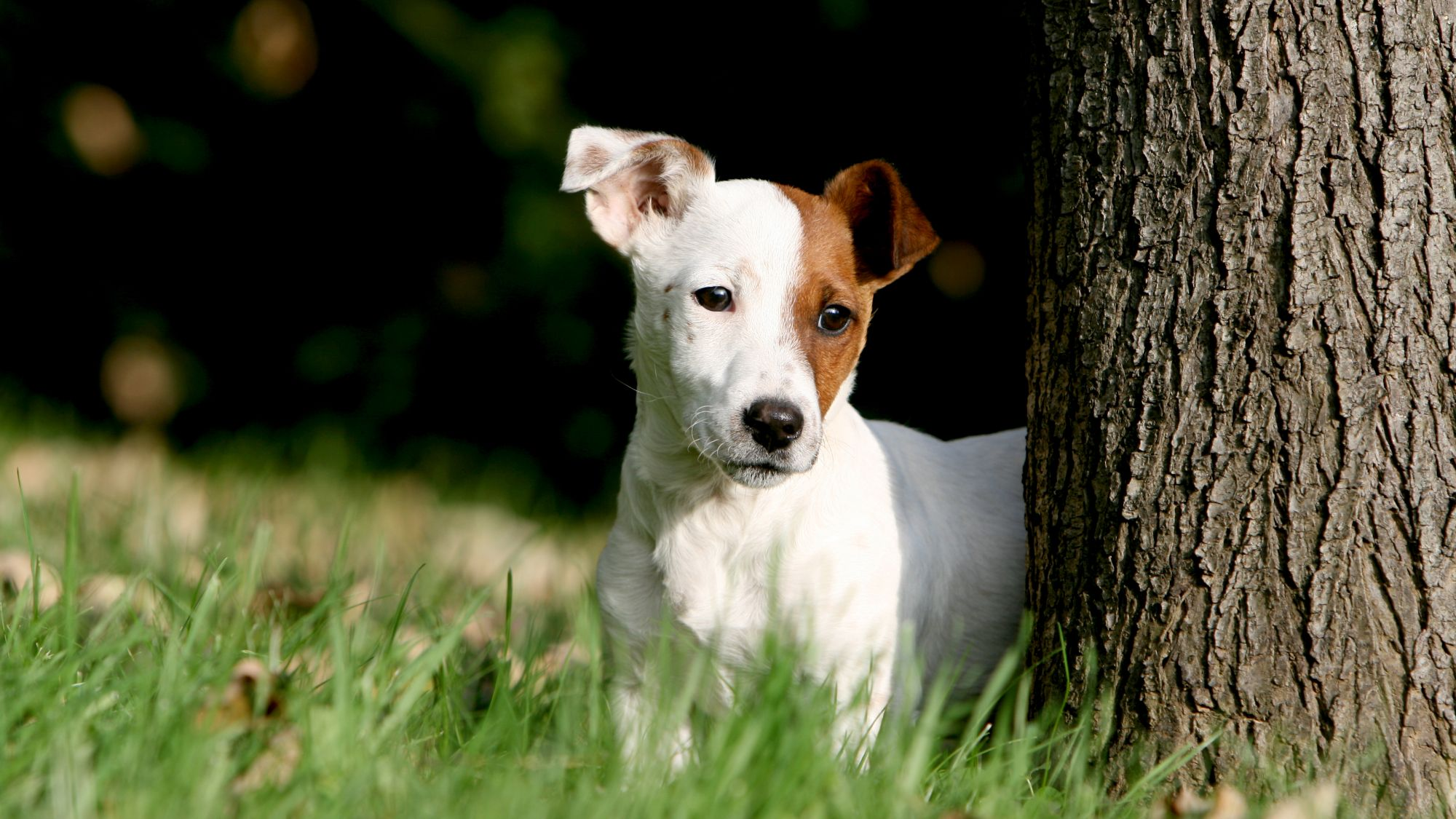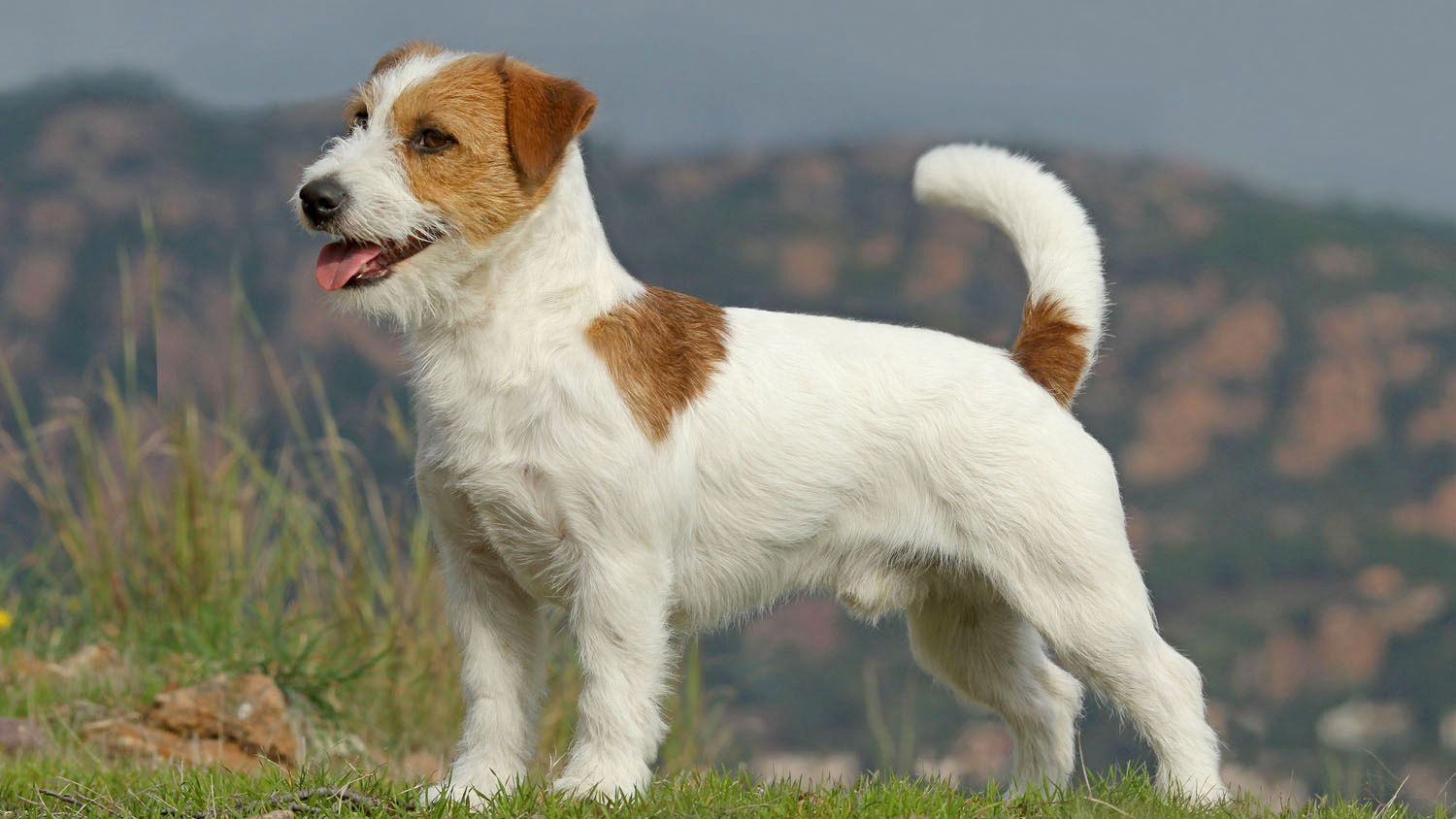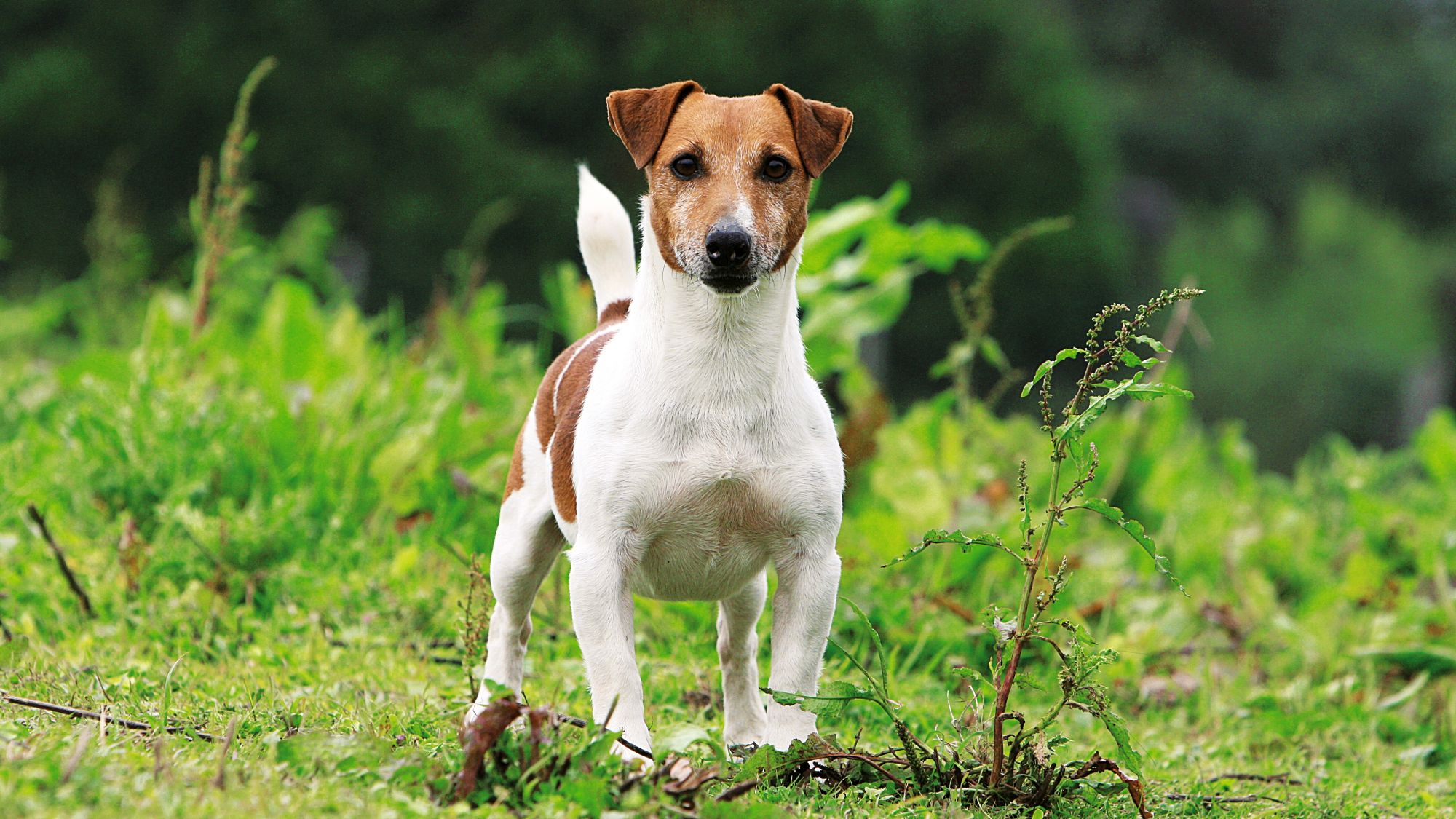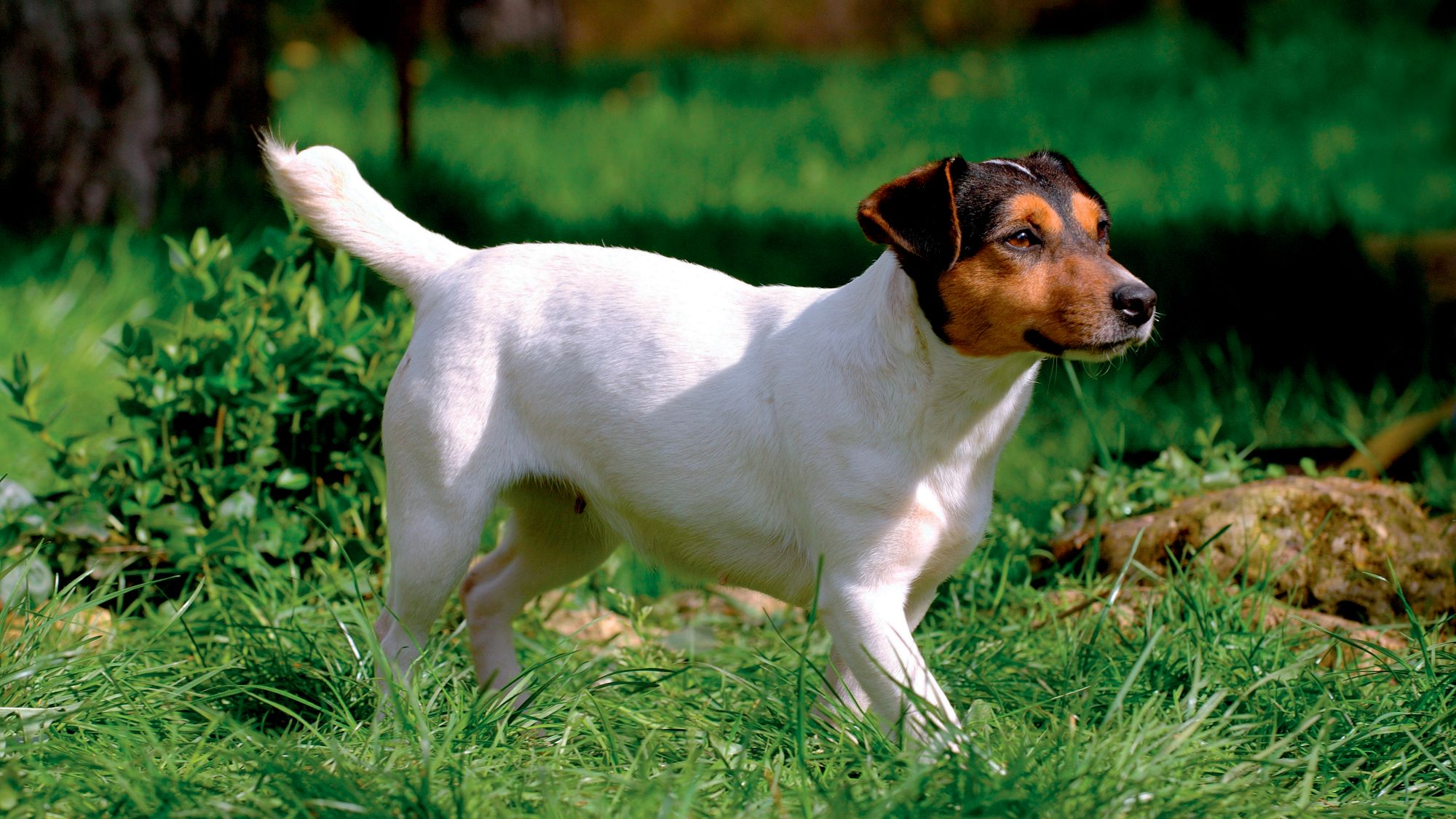Let's talk Jack Russell Terriers
Official name: Jack Russell Terrier
Other names: Jack Russell
Origins: England
Drooling tendencies
1 out of 5Shedding Level
2 out of 5Energy level*
5 out of 5Compatibility with other pets
5 out of 5Warm weather?
2 out of 5Suited to apartment living
3 out of 5Family pet?*
4 out of 5Can be left alone
1 out of 5
| Male | Female |
|---|---|
| Height | Height |
| 9.8 - 11.8 in | 9.8 - 11.8 in |
| Weight | Weight |
| 13.2 - 17.6 lb | 13.2 - 17.6 lb |
| Life stages | |
|---|---|
| Puppy | Adult |
| 2 to 10 months | 2 to 10 months |
| Mature | Senior |
| 8 to 12 years | From 12 years |
| Baby | |
| Birth to 2 months | |

Get to know the Jack Russell Terrier
All you need to know about the breed
There is nothing quite like that Jack Russell Terrier attitude. It has real “Big dog energy” that just happens to be housed in a little dog’s body.
With all the boldness, exuberance and energy, of a far larger animal, the Jack Russell Terrier struts through life with joy. Loyal and devoted, they will be more than pleased to have you along for the ride.
While Jack Russell Terriers can make great family pets, especially when socialized as puppies, they are known to be a bit “nippy” and as such are best suited to families with slightly older children able to understand how to behave around dogs.
Originally bred to accompany hunters, the Jack Russell still has the stamina and temperament that are part and parcel of a working dog’s personality, including the high prey drive for which they were prized. You might be less enthused to see your Jack Russell Terrier taking off after anything that moves, so keeping them on a leash when out and about is always a good idea.
Two things to note about the breed: in spite of their small size, they do need mental stimulation and a lot of exercise, in fact you will likely tire long before they do. And they really don’t take well to being left alone. The breed’s separation anxiety can actually affect their overall health. But with early socialization and professional training, they will soon be able to accompany you as you go about your day.

Two facts about Jack Russell Terriers
1. Did you say something?
It has been said that the Jack Russell Terrier likes the sound of his own voice. Perhaps a kind way of saying that the breed can be a bit barky. Excitable by nature, they will not hesitate to let you know if they are upset. Or content. Or hear something. You get the idea. Calm, but firm training can help get this tendency in check early.
2. How much exercise exactly?
They may be small, but this feisty, lively breed needs to expend their considerable energy every day. A walk around the block twice a day is not going to cut it. Think one hour of exercise a day minimum for your Jack Russell Terrier. Off-leash time nourishes their independent spirit – just make sure they are in a well-enclosed space. As a true terrier, if they can dig their way out, they will escape!
History of the breed
In any event, these hardy terriers were bred to do a job and, while today's Jack Russells may have evolved, the breed still has a strong drive to work, perhaps not surprising considering their high energy reserves. Now a popular companion animal, sprightly Jack Russell Terriers still require room to explore and something to keep their smart minds occupied.
There has been a lot of discussion around the breed’s official recognition. Suffice it to say that they were finally recognized by the AKC in 2001, with their name changed to Parson Russell Terrier. The Jack Russell Terrier Breeders Association followed suit, becoming the Parson Russell Terrier Association of America. Interestingly, the Australian National Kennel Council (ANKC) and the New Zealand Kennel Club (NZCK) are among kennel associations that register both the Jack Russell Terrier and the Parson Russell Terrier as different breeds.
From head to tail
Physical characteristics of Jack Russell Terriers
1.Eyes
2.Nose
3.Skull
4.Body
5.Tail

Things to look out for
From specific breed traits to a general health overview, here are some interesting facts about your Jack Russell Terrier
A skip and a jump
A pretty healthy breed overall, Jack Russell Terriers can be prone to a few select joint problems; from hereditary Legg-Calve-Perthes (LCP) disease - which can be corrected surgically - to a condition known as luxating patella's that causes their knee-caps to move out of position. You can spot symptoms of the latter early, including limping, skipping, and a sitting position that seems as though they are compensating. Your veterinarian can help you decide if your pooch needs surgery or not.
Yawn… the breed bores easily
While training the Jack Russell Terrier can be a relatively easy endeavor thanks to the breed’s inherent smarts, they are known to get bored rather quickly and lose interest. So it's on you to keep those sessions entertaining, changing up here and there to make sure your Jack Russell Terrier stays engaged. If you do, they will learn fast and the training will stick. They were bred as a working dog after all.
Tailored nutrition for Jack Russell Terriers

When choosing food for a Jack Russell Terrier, there are many factors to consider: their age, lifestyle, activity level, physiological condition, and health including potential sickness or sensitivities. Food provides energy to cover a dog’s vital functions, and a complete nutritional formula should contain an adjusted balance of nutrients to avoid any deficiency or excess in their diet, both of which could have adverse effects on the dog. The following recommendations are for healthy animals. If your dog has health problems, please consult your veterinarian who may recommend an exclusive veterinary diet.
Immune System Support
As puppies grow, they will experience big changes and new discoveries. Jack Russell Terrier Puppy helps support your puppy's natural defenses with an exclusive complex of antioxidants including vitamin E.
Digestive Health
Formulated with high quality protein (L.I.P.* ) selected for its high digestibility and prebiotics to support digestive health and a balanced intestinal flora, contributing to optimal stool quality. *Protein selected for its very high digestibility.
Exclusive Kibble
This exclusive kibble has been developed to be perfectly adapted to the jaw of the Jack Russell Terrier puppy, making it easy to pick up and chew.

The main nutritional goals for adult Jack Russell Terriers are:
Dental Health
Small breed dogs are prone to tartar formation. Jack Russell Terrier Adult has an exclusive kibble shape and size to help reduce tartar build-up by encouraging the dog to chew.
Muscle & Vitality Complex
The Jack Russell Terrier is known for his lively temperament. This formula helps maintain muscle mass with optimal protein content and is enriched with a complex of antioxidants to support vitality.
Healthy Skin & Coat
Jack Russell Terrier Adult helps support the skin's role as a barrier with an exclusive complex of B vitamins and amino acids and helps maintain skin health with EPA and DHA.
Exclusive Kibble
The Jack Russell Terrier has a strong and rectangular jaw, and the breed has large teeth that are set square to the jaws. The size, shape and texture of the kibble is designed to be easy for the adult Jack Russell Terrier to pick up and encourages chewing.

After 8 years old, Jack Russell Terriers start facing the first signs of aging. A formula enriched with antioxidants can help maintain their vitality and an adapted phosphorus content will support their renal system. Aging is also accompanied by the modification of digestive capacities and particular nutritional requirements, so food for older Jack Russell Terriers should have the following characteristics:
Ideal Weight
Helps maintain ideal weight by meeting a small dog's specific energy needs.
Vitality Support
Supports heart, kidney and brain health in first stage of aging.
Strong Bones
Helps maintain strong bones with precise blend of calcium and phosphorus.

Caring for your Jack Russell Terrier
Grooming, training and exercise tips
When it comes to exercise, the robust Jack Russell Terrier needs a lot of exercise. Head into nature for long walks, hikes and bike rides. Tired Jack Russell Terriers are a good thing!
While Jack Russell Terriers come with different coat types, none are particularly high maintenance, much like the breed itself. Brush your dog's coat weekly to remove loose hairs, prevent matting or knots and to help distribute their natural skin oils for a cleaner, shiny coat. Trim nails as needed and check ears for wax or dirt regularly.
The breed does have a high prey drive - early training will help avoid problems. As we have said elsewhere on this page, with patience and a firm hand, training headstrong Jack Russell Terriers can be a breeze - as long as you keep it interesting to offset the breed's naturally short attention span.
7/7
All about Jack Russell Terriers
One of the most popular breeds worldwide, Jack Russell Terriers are lively, fun, smart and thoroughly entertaining. These small dogs with big personalities, however, are not for everyone. They need lots of exercise, mental stimulation, a decent amount of attention – this is not a breed that can be left alone much – and early training and socialization. Check all the pros and cons and see if you think the breed is right for you.
Do birds fly? Bred to hunt and burrow into holes, the Jack Russell Terrier has a strong prey drive and a very keen sense of smell. While they might be digging out of boredom or because it’s fun, they might also be picking up the scent of something scurrying around underground. Training can help offset the trait, but not entirely.
Other breeds that might interest you
Read more on this topic
Sources
- Veterinary Centers of America https://vcahospitals.com/
- Royal Canin Dog Encyclopaedia. Ed 2010 and 2020
- Banfield Pet Hospital https://www.banfield.com/
- Royal Canin BHN Product Book
- American Kennel Club https://www.akc.org/
Like & share this page